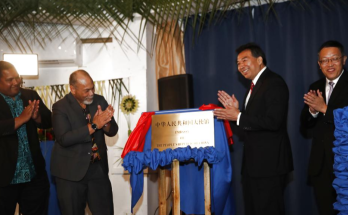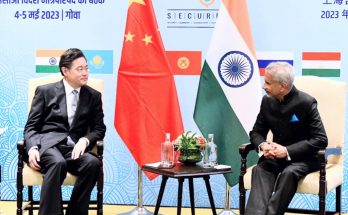 A for Asia. B for Business. C for Culture. And D for Diplomacy and Development. This is the emerging alphabet of multi-faceted engagement between the two Asian powers which are forging a new vocabulary and semantics to script new pathways of cooperation and to reconfigure the evolving world order. The ABCD of India-China relations will find fuller articulation in the September 17-19 visit of Chinese President Xi Jinping to India, a potentially defining trip which could transform ties between the two Asian neighbours and create new opportunities for their 2.5 billion people, one third of the world’s humanity.
A for Asia. B for Business. C for Culture. And D for Diplomacy and Development. This is the emerging alphabet of multi-faceted engagement between the two Asian powers which are forging a new vocabulary and semantics to script new pathways of cooperation and to reconfigure the evolving world order. The ABCD of India-China relations will find fuller articulation in the September 17-19 visit of Chinese President Xi Jinping to India, a potentially defining trip which could transform ties between the two Asian neighbours and create new opportunities for their 2.5 billion people, one third of the world’s humanity.
Why Modi-Xi summit matters
When the leaders of India and China hold talks, the world will be watching closely, and not without reason. They are, after all, Asia’s leading economies with a combined GDP of over $11 trillion and proactive stakeholders in crafting an inclusive international world order. This time round, there is a new configuration, which promises to invest the maiden full-spectrum summit between India’s Prime Minister Narendra Modi and China’s Xi Jinping with an added resonance: on both sides, there are strong-willed leaders who are armed with an unambiguous mandate to take decisive initiatives and are crafting a new chapter in national resurgence of their respective countries. Xi Jinping is widely seen as China’s most powerful leader since Mao Zedong as he holds the triumvirate of positions within the Chinese establishment that confers him near absolute power: he is the General Secretary of the Communist Party of China, the president of the state and chairman of the Central Military Commission. Narendra Modi, on the other hand, is the first India head of government to command a clear parliamentary majority in the last quarter of a century, liberating him from the fret and fever of coalition politics. Translated into simple terms, it means both leaders have the power to walk the talk. Prime Minister Modi’s connection to China dates back to his days as Gujarat chief minister during which he travelled to China four times and managed to net investments running into millions of dollars into his state. The two leaders struck good equations when they first met on the sidelines of the BRICS summit in Fortaleza in July this year. And they are known to admire and hold each other in high regard. This personal chemistry, backed by a synergy of interests, gives both leaders space to build a lasting relationship between the two emerging Asian powers.
 Pragmatism: Business & Development
Pragmatism: Business & Development
Coming back to the ABCD, Business and Development will be the key highlights of the Modi-Xi summit meeting. The talks between the leaders of the world’s two most populous countries will renew the focus on sustaining a new pragmatic model of relationship, which means not letting complex and difficult issues like the decades-old boundary dispute coming in the way of developing and expanding relationship in other areas, be it economic, military and cultural. This imaginative and flexible approach has yielded rich dividends: bilateral trade between India and China has exceeded $65 billion and the two countries are not leaving any stone unturned to scale it up to $100 billion in the not-too-distant future. The burgeoning economic relationship, however, has its flip side: a ballooning trade imbalance of over $30 billion. To bridge this trade imbalance, India is looking to get China to grant market access to Indian IT and pharma companies.
With India’s infrastructure sector hungry for investment and expertise, China has an unprecedented opportunity to partner India in its developmental journey. China is looking to set up dedicated industrial parks in India catering to Chinese companies, help modernise Indian Railways and scale up investments in Asia’s third largest economy. Taking off from their strategic economic dialogue, the two countries are now aiming at structural transformation in their economic ties, from the buyer-seller model to a more enduring investment-driven model. Investments are currently abysmally low: China, which boasts of over $3 trillion in foreign exchange reserves, has invested less than a billion dollars into the emerging market of India. Against this backdrop, one can expect the unveiling of mega investment plans by the Chinese president, and at least two Chinese industrial parks in Gujarat and Maharashtra. China, which is known as the factory of the world, is expected to lend its expertise in assisting the transformation of India, the office of the world, into a manufacturing powerhouse, a key priority of the new government in New Delhi.
While big-ticket economic pacts look set to steal the limelight, the two leaders will also be looking to deepen strategic trust and widen the arc of understanding on issues that are central to their core interests. Maintaining peace and tranquillity on the un-demarcated boundary will be on top of the agenda. In the previous summit meetings, India had underlined that maintaining peace on the border is a prerequisite to building better relation and actualising the full potential of the India-China relations, which remain underleveraged largely due to a lingering trust deficit stemming from the unresolved boundary dispute. In October 2013, during the visit of India’s then prime minister Manmohan Singh to Beijing, the two countries signed a landmark Border Defence Cooperation Agreement, and one can expect buttressing of this framework and additional confidence building measures to ensure friction-free frontiers. Taking a long-range view, the two leaders have an unrivalled opportunity to give a decisive push to boundary negotiations which remain stuck in Phase II, the most crucial and difficult part of the labyrinthine negotiations which will form the basis for the actual delineation of the boundary.
Looking ahead, pragmatism is the operative mantra in the evolving India-China relations, and looks set to stay that way. In the military sphere, the two Asian powers are now looking to build greater trust and intensify interaction between the top military brass. India and China have held three rounds of counter-terror exercise entitled Hand-in-Hand. The defence ministers of the two countries have developed a mechanism of annual dialogue and Indian ships make goodwill visits to Chinese ports.
Refreshingly, India and China have fashioned pragmatic cooperation in the international arena by closely cooperating on a range of cross-cutting issues like climate change and multilateral trade negotiations. They are influential members of leading multilateral bodies like the BRICS, the ASEAN Regional Forum, the East Asia Summit and G20 club of emerging economies.
Clearly, the simultaneous rise of India and China unfolding on the global stage hold the key to an emerging Asian century. With so much at stake in building a harmonious partnership, India and China are now banking on culture and creativity to act as connectors between people of the two countries. Travel, tourism and people-to-people contacts are poised for an upswing in 2014, which both countries have designated as the Year of India-China Friendship. Buddhism provides civilizational connect and Bollywood bonding is becoming stronger – a festival of Bollywood films was launched in China recently to much acclaim. The two countries are now looking to sign a pact on the joint production of films, which promises to build a new popular bridge between them and give Indian filmmakers access to the second largest market in the world after the US.
Skill, Speed and Scale
There will always be sceptics, but a journey of thousand miles begin with a small step, as a Chinese proverb says. Looking ahead, the two Asian giants look set to forge a more constructive and multi-pronged partnership and have accepted a pragmatic model of cooperation in which elements of competition and cooperation will co-exists, hopefully in a creative fusion. The new template of cooperative partnership will be underpinned by ABCD as well as the three S which Prime Minister Modi has spoken of. India needs Skill, Speed and Scale to compete with China, Modi has famously said. This receptivity to learn from each other’s developmental experiences is reflected in a growing realisation in both New Delhi and Beijing that cooperation, rather than conflict, will bring more benefits and spur the rise of both India and China and help shape a balanced Asian century. Rhetorical quibbles apart, the Indian and Chinese dreams of national development and resurgence are entwined at deeper levels. It’s time for the leaders of India and China to walk the talk of an Asian century and make the dreams of their two and a half billion people real.
(Manish Chand is Editor-in-Chief of India Writes Network, www.indiawrites.org, a portal and e-journal focused on international affairs and the India Story)
Courtesy: MEA (www.mea.gov.in)
References
A Shared Vision for the 21st Century of the Republic of India and the People’s Republic of China
India-China relations: Old ties, new model?
Connecting India and China via media, culture and creativity
Xi Jinping’s visit: India hopes for ‘directional change’ in ties with China
Author Profile

- Manish Chand is Founder-CEO and Editor-in-Chief of India Writes Network (www.indiawrites.org) and India and World, a pioneering magazine focused on international affairs. He is CEO/Director of TGII Media Private Limited, an India-based media, publishing, research and consultancy company.
Latest entries
 India and the WorldMarch 3, 2024India-Denmark Connect: Red carpet for Indians to Red Sea cooperation
India and the WorldMarch 3, 2024India-Denmark Connect: Red carpet for Indians to Red Sea cooperation India and the WorldFebruary 17, 2024Munich Security Conference: Jaishankar, Blinken focus on Red Sea, Middle East
India and the WorldFebruary 17, 2024Munich Security Conference: Jaishankar, Blinken focus on Red Sea, Middle East India and the WorldFebruary 14, 2024Munich Security Conference report: Migration, war top security threats
India and the WorldFebruary 14, 2024Munich Security Conference report: Migration, war top security threats India and the WorldJanuary 23, 2024With “Ram to Rashtra” mantra, Modi consecrates Ram temple for national renewal
India and the WorldJanuary 23, 2024With “Ram to Rashtra” mantra, Modi consecrates Ram temple for national renewal










